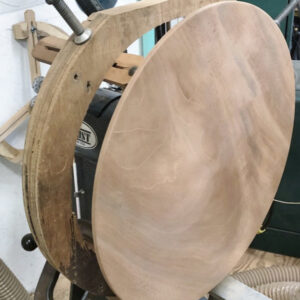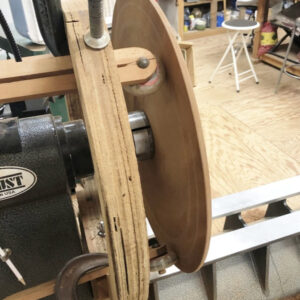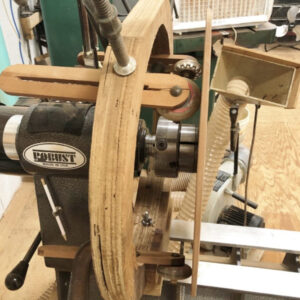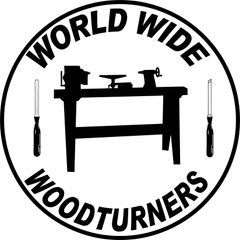 Using a Steady-Rest can be used to help turning large plates and platters. Most times, turning a flat piece to a very thin thickness (less than a quarter of an inch or 6 mm), such as a disc or platter, is not much of a problem. Especially if it is a small diameter around a foot (30 cm) or less.
Using a Steady-Rest can be used to help turning large plates and platters. Most times, turning a flat piece to a very thin thickness (less than a quarter of an inch or 6 mm), such as a disc or platter, is not much of a problem. Especially if it is a small diameter around a foot (30 cm) or less.
 If the wood starts to flex while turning, one simple method to handle it is as follows: One can place and hold the piece with their finger(s) on the back side while slicing across the face with a bowl gouge with the right hand. While you use this technique of bracing the blank, holding a crumpled piece of paper towel or wearing a glove will help to keep from burning your finger(s) . [Editor’s note: a folded white 3M pad is much safer than a glove for this.]
If the wood starts to flex while turning, one simple method to handle it is as follows: One can place and hold the piece with their finger(s) on the back side while slicing across the face with a bowl gouge with the right hand. While you use this technique of bracing the blank, holding a crumpled piece of paper towel or wearing a glove will help to keep from burning your finger(s) . [Editor’s note: a folded white 3M pad is much safer than a glove for this.]
 Bracing the project and turning takes a lot of practice and concentration. It’s quite daunting for an inexperienced wood turner. When turning much larger pieces thin, it becomes quite worrisome; especially for me. With the task of reducing the thickness of a 23 inch diameter piece of mahogany to less than one-fourth inch thickness, I devised a way to use a steady rest to help reduce flexion while thinning.
Bracing the project and turning takes a lot of practice and concentration. It’s quite daunting for an inexperienced wood turner. When turning much larger pieces thin, it becomes quite worrisome; especially for me. With the task of reducing the thickness of a 23 inch diameter piece of mahogany to less than one-fourth inch thickness, I devised a way to use a steady rest to help reduce flexion while thinning.
I had a homemade steady rest that I removed the arms from, then clamped at a 90 degree angle to the steady rest frame. Each of the arms were placed and secured so that the wheels on the arms would gently touch the back of mahogany. This helps in the back and forth movement or flexing of the piece as I turned it thinner.
This resulted in a consistent and even thickness of this large piece. I was able to turn it down to five-sixteenths ( or 5 mm) of an inch.
